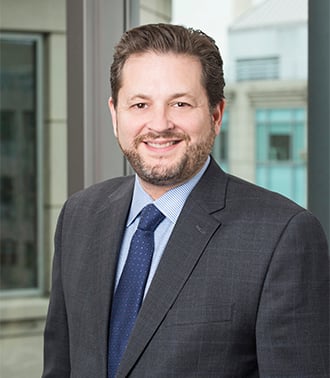Amgen v. Sandoz: Federal Circuit Rules That the BPCIA's "Patent Dance" is Optional
On July 21, 2015, the Federal Circuit issued the first appellate decision interpreting the patent dispute resolution provisions set forth in 42 U.S.C. § 262(l) (part of the Biologics Price Competition and Innovation Act of 2009 (BPCIA)) and determining which of the steps are mandatory. The court held that the information exchange contemplated by § 262(l) is not mandatory, but if an applicant filing an abbreviated biologics license application fails to participate in that information exchange, it must wait for FDA approval of its biosimilar product prior to providing 180 days' advance notice to the reference product sponsor (RPS) that it intends to begin commercial marketing.
Relevant Provisions of the BPCIA
42 U.S.C. §262(k) establishes a streamlined licensure pathway for biological products that are "biosimilar" to, or "interchangeable" with, a reference product licensed by FDA. The RPS receives twelve years of exclusivity. Codified at 42 U.S.C. § 262(l)(2)(A), the BPCIA's patent dispute resolution scheme (often referred to as the "patent dance") sets forth a schedule for a series of exchanges of information and patents by the biosimilar applicant and the RPS. Additionally, the BPCIA introduced a new patent dispute resolution mechanism for biosimilar products submitted for FDA review under the new pathway. The exchanges lead to two types of litigation: (1) immediate patent infringement action on an agreed-upon or restricted list of patents and (2) litigation initiated when the biosimilar applicant provides "notice of commercial marketing" to the RPS at least 180 days prior to commercial marketing of its biosimilar product. Upon receiving this notice of commercial marketing (set forth at 42 U.S.C. § 262(l)(8)(A)), the RPS may seek a preliminary injunction based on any patents that were identified during its information exchanges with the applicant but had been barred from being the subject of declaratory judgment action as a result of the patent dance.
District Court Decision
Sandoz Inc.'s application to market a biosimilar version of Amgen Inc.'s NEUPOGEN® (filgrastim) was the first application to be accepted by FDA under the BPCIA's pathway for biosimilar products. After FDA accepted Sandoz's application in July 2014, Sandoz notified Amgen that it would not participate in the 262(l) patent dance and would not disclose its application or its product's manufacturing information to Amgen. Sandoz alleged that by notifying Amgen of its intention to launch its product immediately upon FDA approval, it provided notice of commercial marketing of its product. On October 24, 2014, Amgen filed a complaint in the Northern District of California seeking an order to compel Sandoz to comply with the patent dance provisions, a declaration that Sandoz could not provide notice of commercial marketing until after FDA approved its product, and rulings that Sandoz violated state laws regarding unfair competition and conversion and infringed Amgen's patent that claimed a method of using filgrastim. Sandoz counterclaimed for a declaratory judgment that its actions were permitted under the BPCIA and that Amgen's patent was invalid and not infringed. In early March 2015, after FDA approved Sandoz's biosimilar application and added it to the Purple Book, Sandoz provided "further" notice of commercial marketing. Amgen moved for a preliminary injunction to prevent the commercial launch of Zarxio®, Sandoz's biosimilar product.
On March 19, 2015, the district court (1) granted partial judgment on the pleadings to Sandoz on its counterclaims; (2) concluded that the BPCIA permits a biosimilar applicant to decide not to disclose its application and manufacturing information to the RPS subject only to the consequences set forth in 42 U.S.C. § 262(l)(9)(C); (3) held that the applicant could give notice of commercial marketing under 42 U.S.C. § 262(l)(8)(A) prior to FDA approval; (4) dismissed Amgen's state law claims with prejudice because it concluded that Sandoz did not violate the information disclosure and notice of commercial marketing provisions of the BPCIA or act unlawfully; and (5) denied Amgen's motion for a preliminary injunction based on its state law claims.1
Federal Circuit Opinion
The court first considered whether the district court erred in concluding that a biosimilar applicant may elect not to disclose its application and manufacturing information to the RPS subject only to the consequences set forth in 42 U.S.C. § 262(l)(9)(C).2 The Federal Circuit agreed with Sandoz that although the statute repeatedly uses the word "shall" to describe the parties' obligations under the disclosure and negotiation procedures and references "application and information required under paragraph (2)(A)", the BPCIA patent dance only provides steps that the applicant "shall" take if it wishes to take advantage of 262(l) to hinder the RPS's ability to initiate patent litigation, narrow the patents subject to "immediate" litigation, and delay litigation on other patents until it provides its 180-day notice of commercial marketing.3 The court noted that in other provisions, the BPCIA states the consequences of an applicant's failure to disclose the required information by the statutory deadline -- the RPS may immediately bring an infringement action under 42 U.S.C. § 262(l)(9)(C) and 35 U.S.C. § 271(e)(2)(C)(ii).4 An infringement action would permit the RPS to access the required information through discovery.5 According to the court, mandating compliance with paragraph (l)(2)(A) would render 42 U.S.C. § 262(l)(9)(C) and 35 U.S.C. § 271(e)(2)(C)(ii) superfluous, thereby violating a cardinal principle of statutory construction.6 Moreover, § 271(e)(4) provides the "only remedies" that may be granted by a court for an act of infringement described in 35 U.S.C. § 271(e)(2)(C)(ii).7
The court next considered whether the district court erred in concluding that a biosimilar applicant may satisfy its obligation to give notice of commercial marketing under 42 U.S.C. § 262(l)(8)(A) by doing so before the FDA licenses its product.8 The Federal Circuit agreed with Amgen that a biosimilar applicant may only give effective notice of commercial marketing after the FDA has licensed its product.9 Requiring that a product be licensed before notice of commercial marketing both ensures the scope of the approved license is known and allows the RPS to determine whether and on which patents to seek a preliminary injunction.10 The court also explained that although in this case 180 days were added to the twelve-year exclusivity period, typically, biosimilar applications will be filed during that twelve-year exclusivity period.11 In this case, the notice of commercial marketing provided by Sandoz in March 2015 served as the operative and effective notice of commercial marketing.12 The court determined that the "shall" provision in paragraph (l)(8)(A) is mandatory because no provision in the BPCIA contemplates consequences for non-compliance with that paragraph after the applicant has complied with paragraph (l)(2)(A).13 The court described paragraph (l)(8)(A) as a "standalone notice provision" not conditioned on any other provisions.14
The court then affirmed the dismissal of Amgen's state law claims of unfair competition and conversion.15 The court also held that Amgen's unfair competition claim based on the alleged violation of § 262(l)(2)(A) was correctly dismissed by the district court because Sandoz did not violate that provision.16 Amgen's appeal from the dismissal of its unfair competition claim based on the alleged violation of § 262(l)(8)(A) was deemed moot as Sandoz may not market Zarxio® before September 2, 2015 (180 days from the date Sandoz gave operative notice on March 6, 2015).17 The court agreed with Sandoz that Amgen failed to establish Sandoz's "ownership or right to possession of property" and "conversion by a wrongful act," two of the requisite elements to sustain a claim of conversion under California law.18
The court also determined that Amgen's appeal from the denial of a preliminary injunction is moot, but ordered that the injunction pending appeal be extended through September 2, 2015.19 Additionally, the court vacated the district court's judgment on Sandoz's counterclaims, directed the district court to enter judgment on those counterclaims consistent with the opinion, and remanded for the district court to consider the patent infringement claim and patent-related counterclaims.20
Additional Opinions Filed by Judges Newman and Chen
Judge Newman agreed with the court that notice of issuance of the FDA license is mandatory and starts the 180-day stay of commercial marketing but dissented-in-part, as she also viewed the documentary and information exchanges set forth in 42 U.S.C. §262(l)(2)(A) as mandatory.21 Judge Chen joined the majority opinion except for the section interpreting paragraph (l)(8) as he does not view paragraph (l)(8)(A) as a "standalone provision" that implicitly provides the RPS a 180-day injunction beyond the express twelve-year statutory exclusivity period.22 Rather, he maintains that if the biosimilar applicant fails to comply with paragraph (l)(2), the provisions in paragraphs (l)(3)-(l)(8) cease to matter.23 Accordingly, he would dissolve the injunction pending appeal.24
Conclusion
As the court explained "[a] statute must be interpreted as it is enacted, not especially in light of particular, untypical facts of a given case."25 In the wake of this decision and the particular facts of this case, certain issues remain unresolved. The BPCIA states that approval of a biosimilar "may not be made effective" by FDA until after 12-year exclusivity lapses. The Federal Circuit noted that the "extra 180 days will not likely be the usual case"26 as biosimilar applications will often be filed during the 12-year exclusivity period. It is unclear whether that means that notice of commercial marketing may be provided upon tentative approval or FDA can provide approval during the 12-year exclusivity. With reference products still in their 12-year exclusivity periods, the patent dance may occur during rather than following the 12-year exclusivity and biosimilars may decide to "dance" in order to gain information to streamline litigation. If, however the exclusivity has expired, in light of this Federal Circuit decision, companies may elect not to "dance." Given the split decision in this case of first impression, the parties may elect to file petitions for rehearing by the panel or en banc Federal Circuit and, depending on the outcome, file a petition for a writ of certiorari with the Supreme Court.
-
Amgen Inc. v. Sandoz Inc., No. 14-cv-04741, 2015 WL 1264756, *8-11 (N.D. Cal. Mar. 19, 2015).
-
Amgen Inc. v. Sandoz Inc., --F.3d--, 2015 WL 4430108, *10-15 (Fed. Cir. July 21, 2015).
-
-
-
-
-
-
-
-
-
-
-
-
-
-
-
-
-
-
-
Amgen Inc. v. Sandoz Inc., --F.3d--, 2015 WL 4430108, *1-9 (Fed. Cir. July 21, 2015) (Newman, J., concurring in part, dissenting in part).
-
Amgen Inc. v. Sandoz Inc., --F.3d--, 2015 WL 4430108, *1-2 (Fed. Cir. July 21, 2015) (Chen, J., concurring in part, dissenting in part).
-
-
-
-



